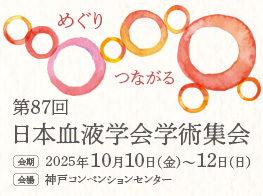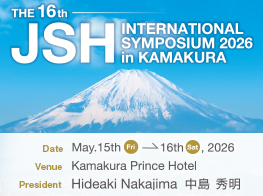名前:森田 剣【京都大学大学院医学研究科人間健康科学系専攻血液・生体防御学研究室】
発表日時:2017年6月24日
発表形式:Poster
Title:
Cluster regulation of runx family by “gene switch” triggers a profound tumor regression of diverse origins
Authors:
Ken Morita1,2, Kensho Suzuki1, Shintaro Maeda1, Akihiko Matsuo1, Yoshihide Mitsuda1, Chieko Tokushige1, Gengo Kashiwazaki3, Junichi Taniguchi3, Rina Maeda3, Mina Noura1, Masahiro Hirata4, Tatsuki Kataoka4, Ayaka Yano1, Yoshimi Yamada1, Hiroki Kiyose1, Mayu Tokumasu1, Hidemasa Matsuo1, Sunao Tanaka1, Yasushi Okuno1, Manabu Muto5, Kazuhito Naka6, Kosei Ito7, Toshio Kitamura8, Yasufumi Kaneda9, Paul P. Liu10, Toshikazu Bando3, Souichi Adachi1,2, Hiroshi Sugiyama3 and Yasuhiko Kamikubo1
Affiliations:
1 Department of Human Health Sciences, Graduate School of Medicine, Kyoto University, Sakyo-ku, Kyoto, Japan
2 Department of Pediatrics, Graduate School of Medicine, Kyoto University, Sakyo-ku, Kyoto, Japan
3 Department of Chemistry, Graduate School of Science, Kyoto University, Sakyo-ku, Kyoto, Japan
4 Department of Diagnostic Pathology, Kyoto University Hospital, Kyoto, Japan
5 Department of Therapeutic Oncology, Kyoto University Graduate School of Medicine, Kyoto, Japan
6 Research Institute for Radiation Biology and Medicine, Hiroshima University, Hiroshima, Japan
7 Department of Molecular Bone Biology, Nagasaki University Graduate School of Biomedical Sciences, Nagasaki, Japan
8 Division of Cellular Therapy and Division of Stem Cell Signaling, The Institute of Medical Science, The University of Tokyo, Tokyo, Japan
9 Division of Gene Therapy Science, Department of Genome Biology, Graduate School of Medicine, Osaka University, Osaka, Japan
10 Oncogenesis and Development Section, National Human Genome Research Institute, National Institutes of Health, Bethesda, MD, USA
Abstract:
Background: Although Runt-related transcription factor 1 (RUNX1) has been generally considered to be a tumor suppressor, a growing body of evidence suggests its pro-oncogenic property in acute myeloid leukemia (AML).
Aims: Demonstrate the anti-tumor potential of cluster regulation of RUNX with a 'gene-switch' in AML as well as in dismal-prognostic solid tumors arising from diverse origins in vivo.
Methods: To assess the effect of RUNX-inhibition in AML cells, we performed series of shRNA-mediated RUNX knockdown experiments. To achieve cluster regulations of RUNX, we have computationally designed an agent which could irreversibly block the RUNX cluster genes expression profiling through dismantling protein-DNA interactions sequence-specifically (CRoX-1).
Results: Firstly, shRNA-mediated silencing of RUNX1 stimulated cell cycle arrest at G0/G1 phase and induced apoptosis in AML cells bearing wild-type p53. Besides, RUNX1 depletion induced remarkable induction of p53 as well as its target gene products and additive knockdown of p53 in these cell lines reverted the phenotype of RUNX1-depletion, indicating that RUNX1 is functionally dependent on proficient p53 pathway. In addition, cycloheximide chase assay revealed that RUNX1 negatively regulates the protein stability of p53 in AML cells. In silico data analysis and ChIP-seq experiments together with series of knockdown and restore experiments identified BCL11A and TRIM24 as critical mediators of p53 pathway activation in RUNX1-inhibited AML cells. Though RUNX1-depleted AML cells exhibited drastically slowed proliferation rate, a small sub-population of leukemia cells retained the proliferation potential even after the silencing of RUNX1. Analysis of these residual AML cells revealed the reciprocal up-regulation of RUNX2 and RUNX3 expressions, suggesting that RUNX2 and RUNX3 might compensate for the loss of RUNX1 functions. As expected, additional knockdown of RUNX2 and RUNX3 in RUNX1-depleted AML cells effectively suppressed their proliferations. Thus the simultaneous targeting of all RUNX family members as a cluster provides more stringent control of leukemia cells. Finally, we examined the antitumor potency of CRoX-1-mediated cluster regulations of RUNX. CRoX-1 treatment was indeed highly effective against leukemia as well as dismal-prognostic solid tumors arising from diverse origins in vitro. Moreover, this reagent was exceptionally well-tolerated in mice and exerted excellent efficacy against xenograft mice models of AML, acute lymphoblastic leukemia, lung and gastric cancers, extending their overall survival periods in vivo.
Since RUNX families take part in diverse physiologic functions not only in AML cells but also in normal hematopoietic cells and in various other vital organ tissues, we might expect criticisms in targeting whole RUNX family that it could trigger undesirable side-effects in vivo. Intriguingly, however, our drug was well-tolerated in vivo and through these experiments, we have coincidentally found that the amount of total RUNX expressions was consistently higher in malignant tissues compared to their normal counterpart ones, and we believe that this gap offers pharmacological window to be targeted in anti-tumor strategies. Furthermore, we found that higher expressions of estimated total RUNX amount demarcate significantly poorer-prognostic patient cohorts in a wide variety of cancers, underpinning the rationality of RUNX-inhibition strategies in cancer treatment.
Conclusion: This work identified the crucial role of RUNX cluster in the maintenance and the progression of cancer cells, and the indicated gene switch technology-dependent its modulation would be a novel strategy to control malignancies.
EHA2017参加レポート
この度は22th EHA Congress参加にあたり、日本血液学会 EHA Travel Awardに採択して頂き誠にありがとうございました。私は今年初めてEHAに参加することもあり、とても新鮮な気持ちで渡欧いたしました。今年のEHAはスペインのマドリードで開催されました。連日30度を超える猛暑で、スーツにネクタイの格好ではとても会場の外を歩き回る気にはならないような良い天気でしたので、普段はフラフラと外へ出掛けがちな私ですが、この会期ばかりは涼しいEHAの会場で一日を過ごしておりました。Plenary sessionなどの口演発表を中心に聴講しておりましたが、欧州を代表する血液学者の生のプレゼンテーションは論文を読んでいるだけでは伝わらない研究のプロセスを肌身で感じることができ大変勉強になりました。特に「造血幹細胞に様々な蛍光色素を遺伝子操作によりランダムに導入し染め分け、その挙動を探る」という発表ではその斬新なアイディアや、視覚的なインパクトなどが私の脳裏に強く焼きつき、将来はこのような素晴らしい研究を自らの手で開拓したいという思いを強く致しました。
私は今回、転写因子RUNXをクラスターとして制御するpyrrole-imidazole polyamideに関する発表を行いました。RUNXは造血器腫瘍において癌抑制遺伝子と癌遺伝子の二面性を併せ持つ、重要かつ大変興味深い遺伝子ですが、急性骨髄性白血病(AML)ではRUNX1、RUNX2、RUNX3の発現を同時にRUNXクラスターとして抑制すると腫瘍細胞の増殖を非常に強く抑制することができます。pyrrole-imidazole polyamideはその名の通りpyrroleとimidazoleが複数連結した中分子化合物ですが、1対の向かい合わさったpyrroleとimidazoleの組は細胞内でゲノムDNAの特定の塩基(A, C, G, T)を識別して結合するというとてもユニークな化合物です。このpyrroleとimidazoleをヘアピン構造により任意に連結した分子を合成すると、ゲノムDNA上の任意の連続配列に特異的に結合するpolyamideを作成することができます。更にこのpolyamideをアルキル化剤で修飾した化合物は細胞内に取り込まれると結合先のDNA配列周辺を選択的にアルキル化することでRUNXの転写因子としての働きを抑制することが可能となり、結果的に強い抗癌活性を発揮します。今回のEHAでは世界各地から来訪された参加者より多くの叱咤激励をいただき、今後の研究を進めていく上で大変参考になるアドバイスを得られたことが何よりの収穫でした。
今回、EHA Travel Awardに採択いただき大変光栄に存じます。このような機会を与えて頂きました日本血液学会事務局及び国際委員会の諸先生方に心より感謝申し上げます。自身の研究分野のみならず、様々な研究分野で活躍している多くの研究者の方々との交流で、臨床応用につながる基礎研究を続けたいという思いを強く致しました。将来は市販の風邪薬のように簡単かつ安全に服用できて、一方で強力な抗癌作用を発揮するような新薬の開発を目指して引き続き邁進しようと思います。日頃より御指導いただいております京都大学大学院医学研究科 足立壮一教授、上久保靖彦准教授、またこの道に導いて下さった東京大学大学院医学系研究科 黒川峰夫教授、日本赤十字社医療センター 鈴木憲史先生、並びに本研究に関わって頂いた全ての皆様にこの場を借りまして厚く御礼申し上げます。最後に、今回の受賞を一緒に喜んでくれた家族への日頃の感謝をここに記し、私の22th EHA Congress Travel Award 受賞報告とさせていただきます。



